The warm spring breeze brings hope for a lush lawn. But, birds can quickly eat the grass seed before it grows. This is a common problem for gardeners. Don’t worry, there are ways to stop birds from eating your grass seed and protect your lawn.
Key Takeaways
- Employ various bird deterrents, such as motion-sensing sprinklers, reflective surfaces, and bird-repellent liquids, to keep feathered pests at bay.
- Protect grass seed with netting, straw mulch, or burlap sheets to physically block birds from accessing the valuable seedlings.
- Utilize alternative feeding options, like bird feeders, to divert the birds’ attention away from your lawn.
- Overseed your lawn with extra grass seed to offset the losses from bird consumption.
- Maintain a healthy, well-kept lawn to discourage birds from targeting your grass seed in the first place.
Why Are Birds Attracted to Your Lawn?
Birds love lawns because they find lots of food in the form of grass seeds. These seeds are like an endless feast for them. They also look for warm spots in lawns to build their nests.
Seeds as Unlimited Buffet
Birds naturally search for seeds to eat. So, all types of grass seeds on your lawn are at risk. These seeds are easy to get to and keep coming back, making your lawn a popular spot for them.
Warm Nesting Spots
Lawns with warm, hidden areas are great for birds looking for a place to nest. The tall grass and hiding spots make it safe and cozy for them to build their nests and care for their babies.
Knowing why birds like your lawn helps you stop them from eating your grass seed. By understanding what draws them in, you can find ways to keep your lawn safe and keep the birds away.
“Grass seed is like an unlimited buffet for birds, and they simply can’t resist the temptation.”
Are Birds Dangerous to Your Lawn?
Birds might not be a threat on their own, but they can harm newly seeded lawns. They can eat most of the grass seeds, leaving the lawn uneven and sparse. But, in small numbers, birds can help by eating worms and insects that could harm the grass.
Birds like sparrows, finches, pigeons, blackbirds, meadowlarks, and cardinals love to eat grass seeds. They see the new seed as a never-ending feast. This can stop the lawn from growing lush and healthy.
The damage from birds can look like uneven growth or bare spots where all the seeds are gone. This is a big problem in late summer and early fall, the best times for growing grass seed.
“Grass seed is a prime target for birds, making it crucial to protect it from their interference.”
Homeowners can use several ways to stop birds from eating their grass seed. Using netting, bird deterrents, and giving them other food can help. By doing this, homeowners can keep their lawn looking great and free from bird damage.
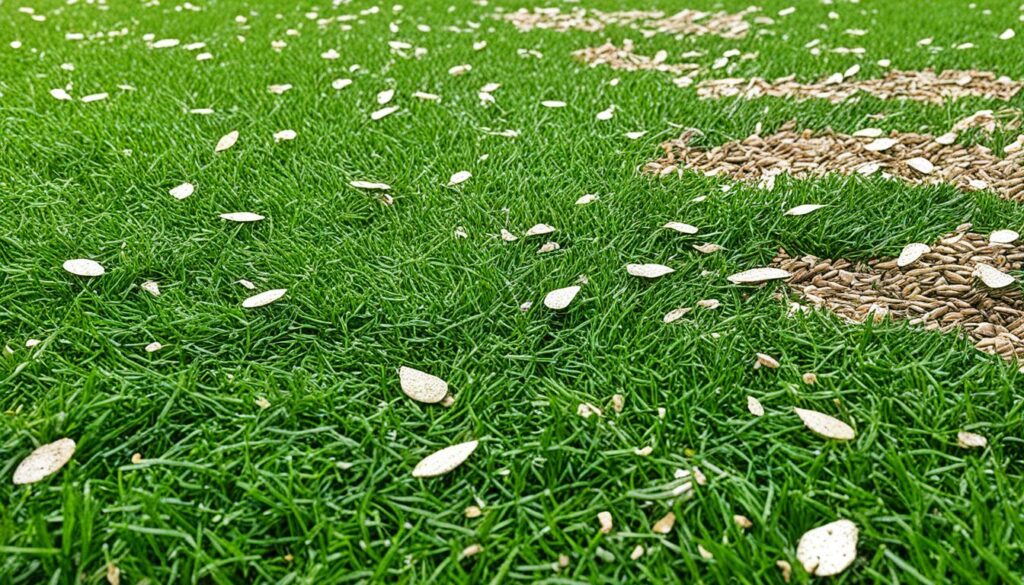
Identifying Bird Damage on Your Lawn
Birds eating your lawn’s grass seeds often leave small holes in the soil. These holes are about 1 to 1.5 inches wide. Birds dig them with their beaks to get to the seeds.
Seeing these holes can be upsetting for homeowners who have carefully planted their lawns. But knowing how to spot bird damage helps you protect your lawn. This way, you can keep your lawn healthy and green.
Holes in the Soil
Small, round holes in the soil are a clear sign of bird activity. Birds dig these holes to get to the grass seeds you’ve planted. They use their sharp beaks to dig and eat the seeds.
You might also see seed husks or partly eaten grass seedlings around. This confirms that birds are eating your lawn’s seeds.
“Identifying bird damage on your lawn is the first step in reclaiming your grass seed from these feathered foragers.”
Knowing about bird damage lets you take steps to protect your lawn. This ensures your grass seed grows well and your lawn looks great.
How to Stop Birds from Eating Grass Seed?
Stopping birds from eating your grass seed can be tough, but there are ways to do it. Birds like sparrows, finches, starlings, and pigeons love to eat grass seed. Using different methods, you can keep these birds away and help your lawn grow.
One easy way is to use bird-proof fencing or mesh around the seeded area. This stops bigger birds like pigeons from getting to the grass seed.
Another method is to use visual deterrents. Hang CDs or foil to reflect sunlight and scare the birds. Or, put realistic-looking plastic or fabric model owls or hawks in your garden to scare them away.
For a natural way, try covering the grass seeds with compost or topsoil after you plant them. This makes it hard for birds to see the seeds, so they won’t be tempted to eat them.
Using sound deterrents can also work well. Hang tin cans or wind chimes to make loud noises that scare birds away. Or, play recordings of bird predators, like owls or hawks, to scare them off, especially when they’re most active.
By using these effective bird deterrents, you can keep birds away from your grass seed. This will help you have a lush, healthy lawn.

Use Fake Predators
Using fake predators like rubber snakes and owls is a smart way to keep birds away from your grass seed. These fake animals look real and make birds think they’re in danger. This can help keep your lawn safe.
Rubber Snakes and Owls
Place rubber snakes and owls around your lawn to scare birds away. Their fake movements and shadows make birds think there’s a real threat. This simple trick can really help keep birds off your grass.
It’s important to move the fake predators around often. Birds can get used to them if they stay in one spot. By changing their location, you keep them guessing and more effective. Using fake predators with other methods, like sprinklers or shiny surfaces, can make your lawn even safer.
To keep birds away, make your yard feel unsafe for them. Fake predators use birds’ natural fears to your advantage. This way, you can protect your grass seed from birds.
Install Motion-Sensing Sprinklers
Using motion-sensing sprinklers is a smart way to keep birds off your new lawn. These devices startle birds with a sudden water burst when they move on the lawn. They’re smart because they only spray water when birds come near, saving water.
Motion-sensing sprinklers for bird deterrence work by startling birds and breaking up their feeding. When a bird lands, the sprinkler’s sensors kick in and spray water. This scares the bird away and keeps it from coming back. They’re great for big lawns or gardens.
- Motion-sensing sprinklers cost between $42 and $180 on Amazon, depending on what they do and how big the area they cover.
- They’re not just for birds; they also keep away deer, dogs, and mice. So, they’re a smart technology to keep birds off lawn.
- Some sprinklers, like the Solar Sprinkler, don’t need to be plugged in. This makes them easy and handy for homeowners.
- You can set how far the sprinkler covers to protect just the right amount of grass seeds.
Adding motion-sensing sprinklers for bird deterrence to your lawn care can really help. It stops birds from eating your grass seeds. This means you’ll have a healthy, green lawn all season.
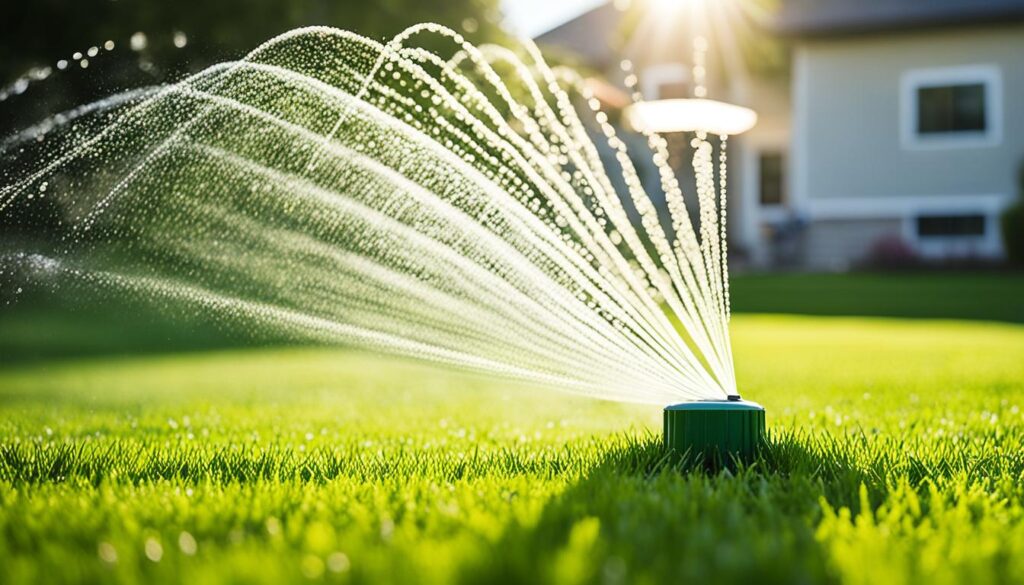
Spray Bird-Repellent Liquids
If birds are eating your new grass seed, bird-repellent liquids can help. These liquids have things like aluminum ammonium sulfate or methyl anthranilate. These make birds taste something bad, so they won’t come near.
Commercial and DIY Options
There are many commercial bird-repellent liquids available. Brands like AVIAN Control, AVIAN Migrate, and Avian Fog Force™ TR Bird Repellent are out there. They can cover a lot of ground, with AVIAN Control treating up to 4 acres per gallon.
Or, you can make your own homemade bird deterrents. Use things like weak black tea or peppermint oil. These can work just as well to keep birds away from your grass.
Whether you pick a store-bought or homemade option, follow the directions closely. You might need to reapply every 7 to 14 days to keep it working.
“I used Bird Stop to deter Starlings from my property, and it worked like a charm after years of failed attempts with other products.”
Liquids from brands like Bird B Gone are safe for plants and people. They’re great for controlling birds in many places, like golf courses, farms, lawns, and businesses.
Use Bird-Repellent Grass Seeds
Protecting your lawn from curious birds can be tough, but there’s a smart solution – bird-repellent grass seeds. These seeds have a coating that makes them unattractive to birds. It’s a harmless way to keep them away.
The coating on bird-repellent grass seeds tastes bad to birds. This keeps them away without hurting the grass. It’s a clever way to have a healthy lawn and stop birds from eating it.
Choosing coated grass seeds to deter birds is smart and good for the planet. You can find these seeds at many trusted lawn and garden stores. It’s easy to add them to your lawn care routine.
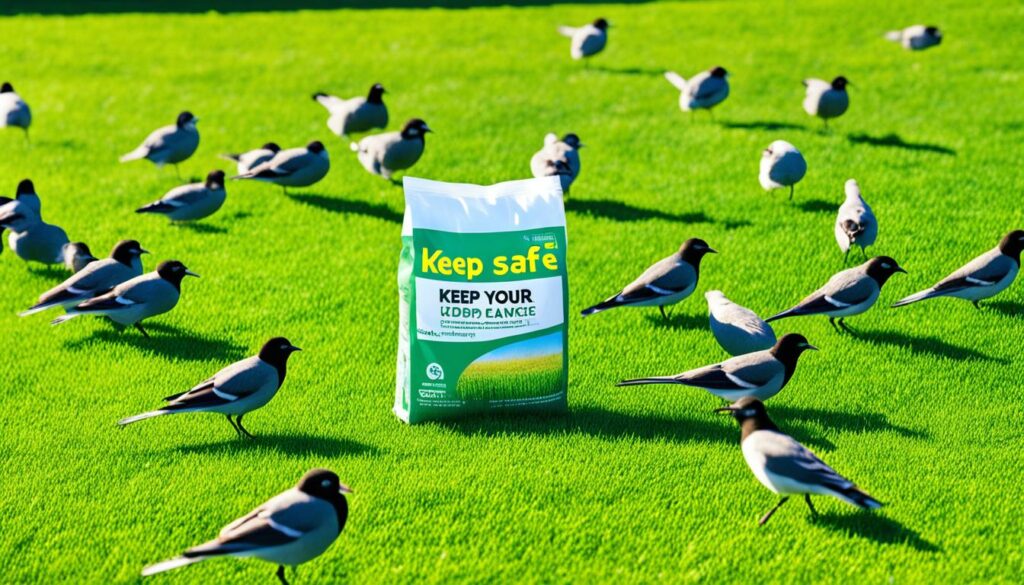
With bird-repellent grass seeds, you can have a beautiful, healthy lawn without worrying about birds. This easy fix saves you time, money, and the hassle of dealing with birds.
Cover with Straw Mulch
One effective way to keep birds from eating your grass seeds is to cover them with straw mulch. This simple method acts as a barrier. It makes it hard for birds to get to the seeds and dig in the soil.
Straw mulch does more than just keep birds away. It also helps keep the soil moist, which is key for healthy grass growth. This moist soil helps seeds germinate faster and grow stronger, leading to a lush lawn.
When putting down the straw mulch, aim for a thickness of 1 to 2 inches. This amount hides the seeds from birds but still lets water and air in. Make sure to spread it evenly over the seeded area for a solid barrier.
Using straw mulch is a budget-friendly, natural way to protect your seeds. As the grass grows, the straw breaks down. This adds nutrients to the soil, making your lawn healthier.
To keep birds away from your grass seed, create a barrier they can’t easily get past. Straw mulch is a great choice. It keeps birds away and helps your new lawn grow strong.
Use Burlap Sheets
Protecting your freshly planted grass seed from hungry birds can be tough. But, using burlap sheets is a great solution. It acts like straw mulch, creating a barrier that keeps birds away. The burlap lets water and sunlight in while keeping the seeds safe.
Removing Burlap After Germination
Remember, burlap is only a short-term fix. Once the grass seeds sprout, you should take it off. It can block sunlight and stop the grass from growing well. Try to remove the burlap in 2-3 weeks after the seeds start to grow.
Using burlap sheets to protect grass seed and removing them at the right time helps keep birds away. It also lets your lawn get the sunlight and air it needs. This method, along with other bird deterrents, can keep your lawn looking great.
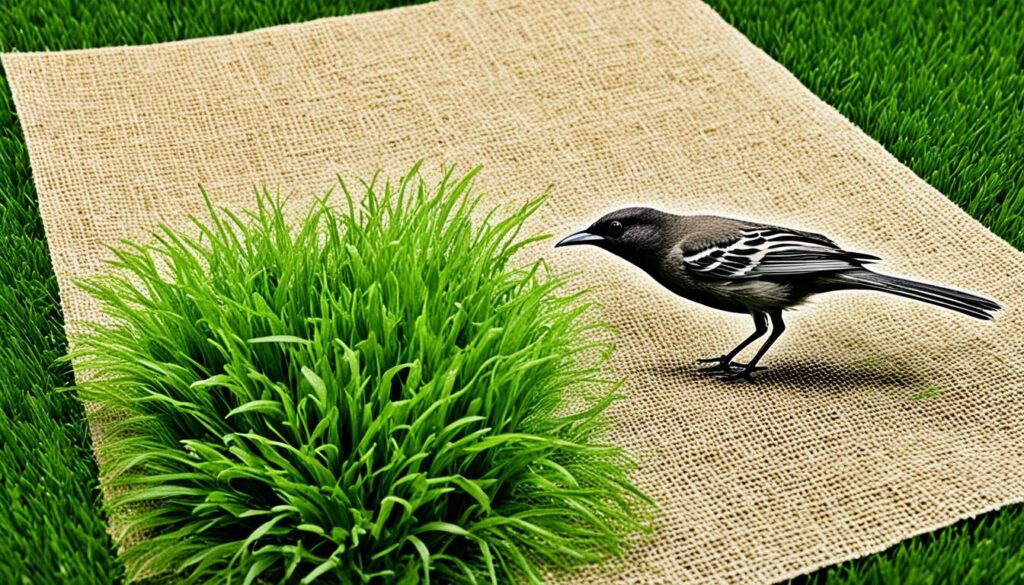
“Covering grass seed with fabric like burlap is a simple yet effective way to shield it from birds while still allowing essential elements like water and sunlight to reach the seeds.”
Install Netting
Installing netting is a great way to keep birds away from your new grass seed. This method acts as a barrier, stopping birds from reaching the netting to keep birds off lawn and physical barriers to protect grass seed. By doing this, you help your grass grow strong and healthy.
Put the netting up right after you spread the grass seed. Make sure it’s before the birds find out about the new food. The netting must be tied down well, with no holes for birds to get through. This is key to keeping your lawn looking great.
- Choose a high-quality, UV-resistant netting made for lawns and gardens.
- Secure the netting to the ground with landscape pins or other anchors.
- Make sure the netting is tight and doesn’t sag, so birds can’t get through.
- Keep the netting up until the grass seeds have grown strong roots.
By acting early, you can keep hungry birds away from your grass seed. This helps your lawn grow well. A well-protected lawn means a beautiful outdoor space.
Use Reflective Surfaces
Keeping your lawn safe from birds can be tough, but using reflective surfaces helps a lot. Birds don’t like shiny things that make their vision blurry. This can keep them away from your lawn.
Mirrors and Aluminum Foil
Putting mirrors or aluminum foil around your lawn is an easy way to keep birds away. These shiny things make birds think there’s a threat around. So, they won’t come near your grass seed.
- Many people say aluminum foil is great for keeping birds away from grass seed.
- Birds don’t like shiny things, and aluminum foil is perfect because it reflects a lot.
- Using aluminum foil lets you put strips on the ground or hang them up. This makes the sun reflect and keeps birds away from your grass seed.
- Not just aluminum foil, but also shiny things like CDs, mirrors, and party streamers can keep birds away from your lawn.
These methods might not work for everyone, but trying out reflective surfaces to deter birds is cheap and easy. It can help keep your lawn bird-free.
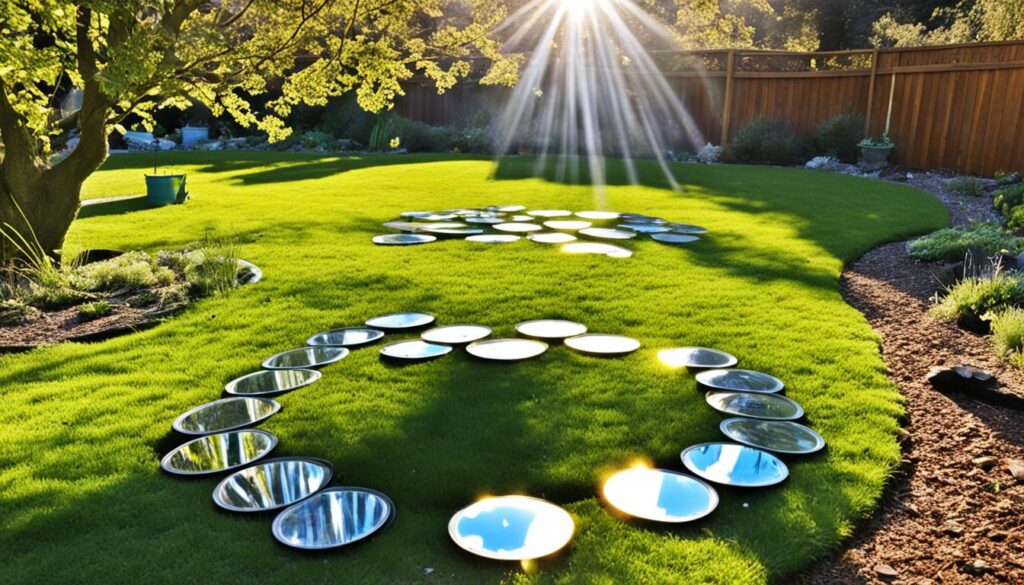
Bird Tapes and Flags
Keeping birds away from your lawn can be tough, but there are smart ways to do it. Using bird tapes and flags is a clever solution. They make a noise and look that birds don’t like, so they stay away.
Bird tapes have a flashing, holographic effect that scares birds off. They reflect light and move in a way that birds find odd. Also, colorful flags or windmills can keep birds away. The bright colors and movement surprise birds and make them leave your lawn.
These methods are easy to set up and can be a big help in lawn care. By making your lawn look and sound bad to birds, you can stop them from eating your grass. This keeps your lawn looking great.
- Holographic bird tapes create a flashing, shimmering effect that deters birds.
- Brightly colored flags and windmills can also be effective in keeping birds away due to their vibrant colors and movement.
- These visual and auditory cues create an unsettling environment for birds, causing them to avoid the area.
Effective bird deterrence methods can help you maintain a lush, healthy lawn by preventing birds from eating your grass seed.
Using a mix of bird deterrence methods, like bird tapes and flags, works best. This way, you can keep your lawn free from birds.
Install Bird Feeders
Installing bird feeders around your lawn can distract birds from your newly seeded areas. This method offers birds an alternative food source, keeping them away from your grass seeds. Using bird feeders can be a smart way to protect your lawn from bird damage.
Think about your lawn’s layout and where birds usually hang out when placing feeders. Putting them along the lawn’s edges can help keep birds away from your seeds. Make sure to clean and disinfect the feeders often to keep the birds safe and coming back.
Research shows decoy feeders can move bird activity away from lawns by up to 80%. By offering a steady food supply, you’re giving birds an alternative food source. This can greatly reduce their interest in your grass seeds.
“Decoy feeders can divert bird activity away from seeded lawns by up to 80%.”
This method also helps the local bird population by providing a reliable food source. It supports their natural foraging habits and lessens their need for your grass seeds.
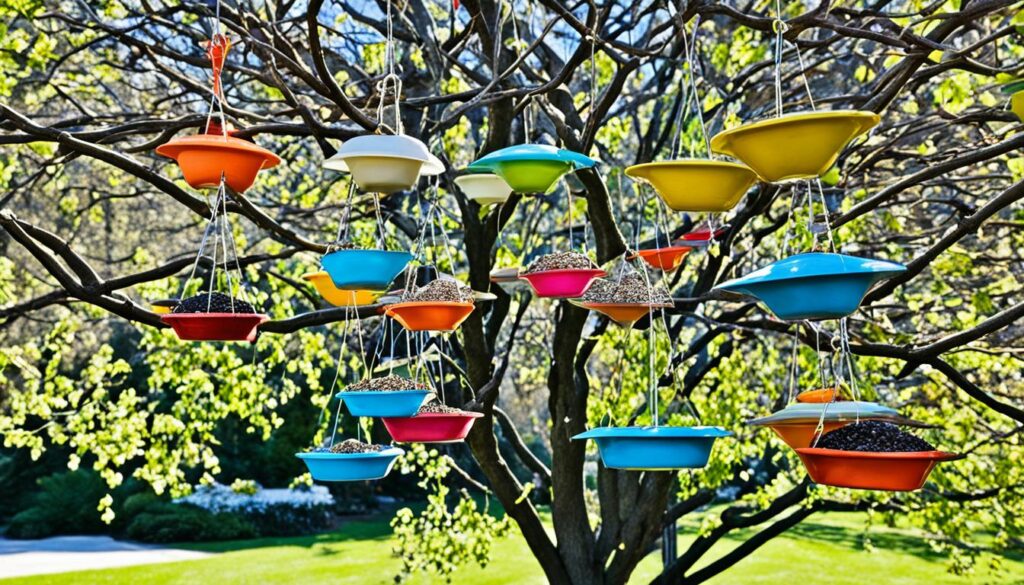
Using a mix of deterrents may be needed since birds can get used to one method over time. Adding bird feeders to your strategy can help keep your lawn safe from birds. It also helps the local bird community.
Disinfect the Lawn
To stop birds from eating your grass seed, consider disinfecting the lawn. Birds like lawns with lots of worms and insects. Using safe insecticides can make your lawn less inviting, keeping birds away from your seeds.
Here are the steps to disinfect the lawn to deter birds:
- Get rid of insects and worms. Use a pet-safe insecticide to clear out food sources that attract birds.
- Keep the grass short. Regular mowing makes it hard for birds to hide and nest, keeping them away from your lawn.
By disinfecting the lawn and removing food sources for birds, you make your yard less welcoming. This approach greatly lowers the chance of birds eating your grass seed. It’s a key step in stopping birds from eating grass seed.
“Disinfecting the lawn is an often-overlooked but highly effective way to make your property less attractive to birds looking for an easy meal.”
Use Absorption Seeds
Keeping your lawn green can be tough, especially when birds love your grass seeds. But, there’s a simple way to beat them – absorption grass seeds. These seeds soak up water fast, leading to quick growth that birds can’t keep up with.
Birds like pigeons, buntings, starlings, goldfinches, and sparrows love grass seeds. Using absorption grass seeds helps your lawn grow before they can eat it. This way, your hard work isn’t wasted.
These seeds germinate fast, usually in 7-21 days, depending on the type and the weather. This quick start makes your lawn less inviting to birds that prefer easy food.
When you plant your lawn, cover the seeds with a thin layer of soil, about 1/4 inch deep. Keep the soil moist until the seedlings are strong. Cutting the grass when it’s 2-3 inches tall and using a balanced fertilizer will help your lawn grow well.
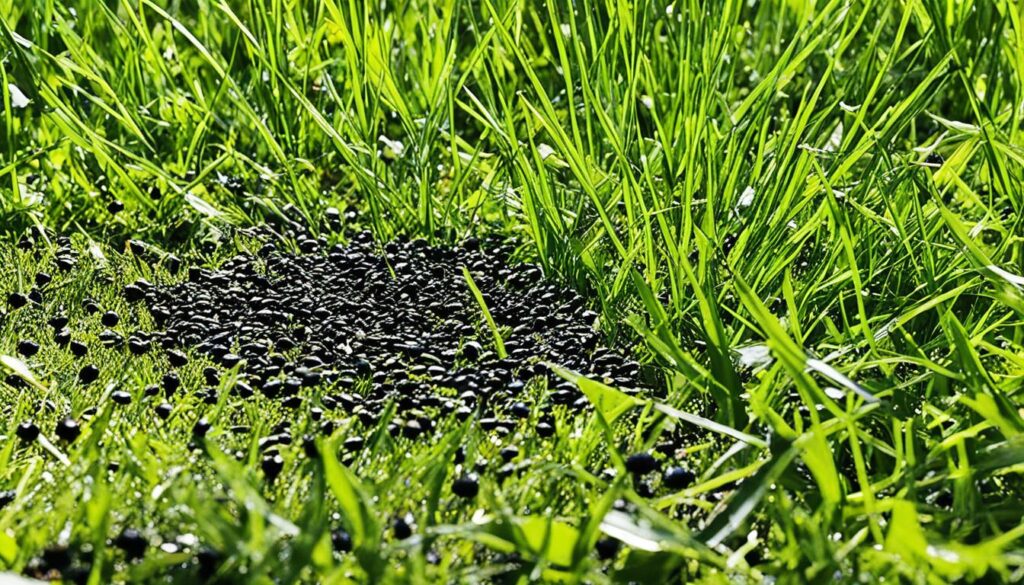
To protect your lawn more, use bird-repellent methods with absorption grass seeds. Consider motion-sensing sprinklers, bird-repellent liquids, or straw mulch over the seeded area until the grass grows.
Using absorption grass seeds gives your lawn a chance against birds. This way, you can enjoy a lush, green lawn you’re proud of.
Hang Wind Chimes
If you’re having trouble keeping birds away from your grass seed, try hanging wind chimes. The sounds of wind chimes can make a place unpleasant for birds. This can stop them from landing and eating your grass seed.
Studies show that small birds don’t like loud noises. So, wind chimes can be a good way to keep them away. But, birds can get used to sounds over time. To keep them away longer, use more wind chimes in the area.
Deep, loud wind chimes work best because birds don’t like those sounds. Don’t use small, melodic wind chimes because they might attract birds.
Look for wind chimes made with reflective materials like glass or metal. Birds don’t like shiny surfaces. Bamboo wind chimes are also good because they’re less noisy and don’t reflect light.
With time, birds will get used to wind chimes, especially if they’re not near their favorite spots. By placing the wind chimes carefully, you can keep birds away. This way, you won’t disturb the natural sounds of birds singing.
Overseed with Extra Grass Seeds
If birds eat some of your grass seeds, you can fix it by overseeding. This way, even if birds eat some seeds, you’ll still have enough to grow a healthy lawn.
Overseeding every year keeps your lawn healthy and makes up for bird damage. Birds like quails, doves, pigeons, sparrows, finches, and starlings eat grass seeds. By adding more seeds, you’re making up for the loss birds cause.
- Put more grass seed on the problem spots to make sure your lawn looks full, even if birds eat some seeds.
- Pick grass seed types that birds don’t like, like ryegrass or fescue, to keep them away from your lawn.
- Try overseeding with other bird keepers like netting, shiny surfaces, or sprinklers that move when birds come near.
“Overseeding is a simple and effective way to compensate for any bird damage to your grass seed, helping you maintain a lush, healthy lawn despite their unwelcome presence.”
By overseeding with extra grass seed, your lawn stays green and healthy, even with birds around. This method, along with other bird-deterrents, helps protect your grass seed from birds.
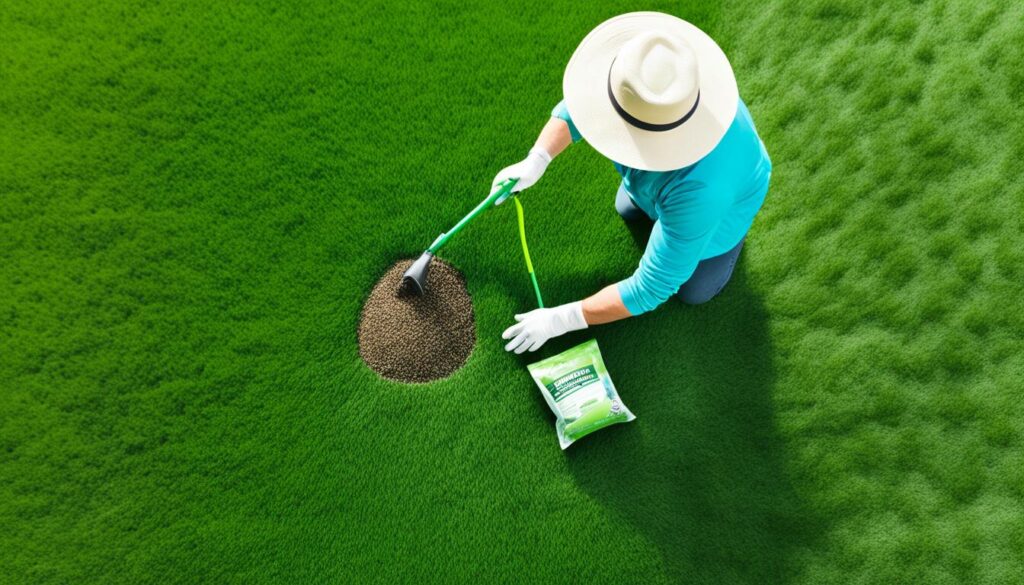
Conclusion
Keeping birds away from your new lawn is key for its growth and looks. Using fake predators, motion-sensing sprinklers, and bird-repellent liquids can help. Physical barriers and offering them other food also work well.
Try using bird-resistant grass seed and shiny objects to keep birds away. Installing netting is another good idea. This way, your lawn will be less inviting to birds.
A well-protected lawn looks better and helps birds and other wildlife live nearby without harming your garden. With the right deterrents, you can keep birds off your lawn. Enjoy the lush, green lawn you’ve worked so hard for.
FAQ
What are some effective methods to stop birds from eating grass seed?
To stop birds from eating grass seed, you can use fake predators like rubber snakes and owls. Motion-sensing sprinklers can also work well. You can spray bird-repellent liquids or use bird-repellent grass seeds.
Another option is to cover the lawn with straw mulch or burlap sheets. Installing netting over the seeded area is also effective.
Why are birds attracted to lawns in the first place?
Birds like lawns because they offer lots of food in the form of grass seeds. These seeds are like an “unlimited buffet” for them. Lawns also have warm, sheltered spots that are perfect for building nests.
Are birds dangerous to a newly seeded lawn?
Birds aren’t dangerous on their own, but they can harm newly seeded lawns. They can eat most of the grass seeds, leaving the lawn uneven and sparse. But, in small numbers, birds can help by eating worms and insects that might harm the grass.
How can you identify if birds are damaging your lawn?
If birds are damaging your lawn, you’ll see small holes in the soil, about 1 to 1.5 inches deep. These holes are made by birds digging for grass seeds with their beaks.
What are some ways to create a physical barrier to keep birds off the lawn?
To keep birds off your lawn, you can use physical barriers. Cover the grass seed with straw mulch or burlap sheets. You can also install netting over the seeded area to block birds from getting to the seeds.
How can reflective surfaces and noise deterrents help keep birds away?
Reflective surfaces like mirrors or aluminum foil can scare birds away. They think the moving reflections are a threat. Wind chimes can also make a lot of noise, making your lawn an unpleasant place for birds.
Can providing alternative food sources help divert birds from the grass seed?
Yes, putting bird feeders around your lawn can distract birds from your grass seeds. By offering them food elsewhere, you can keep them away from your lawn.
What other methods can help protect the grass seed from bird damage?
Other ways to protect grass seed include using bird-repellent liquids or coatings. You can also get rid of worms and insects that might attract birds. If birds do eat some seeds, you can overseed the area to fill it back in.
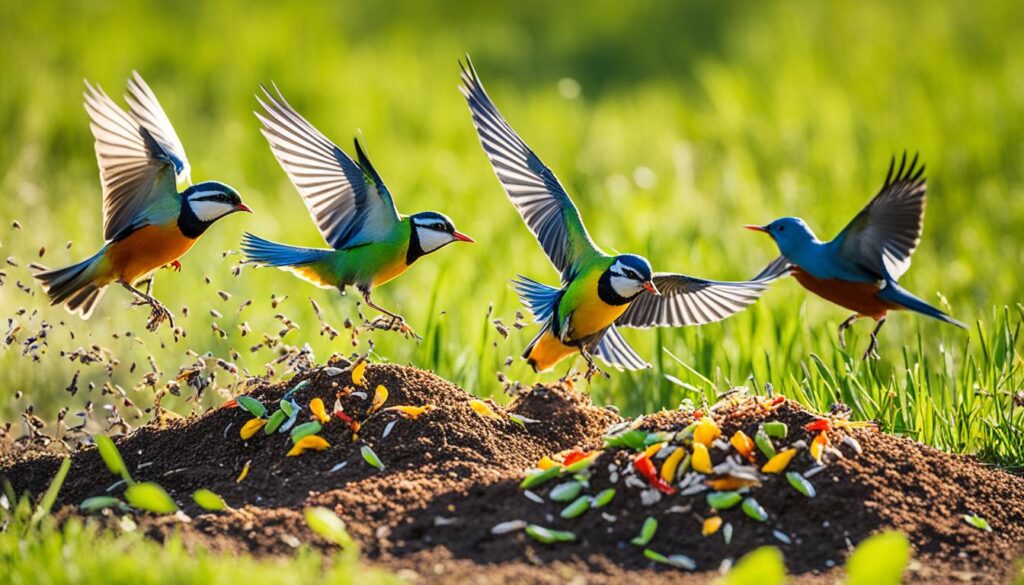

I am really inspired together with your writing skills as smartly as with the format
to your blog. Is that this a paid subject or did you modify
it yourself? Either way stay up the nice high quality writing,
it’s rare to see a nice blog like this one nowadays.
Blaze AI!